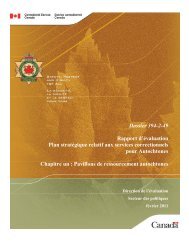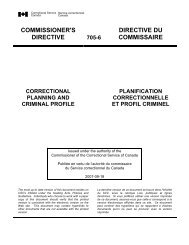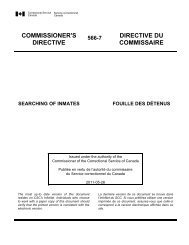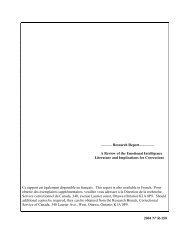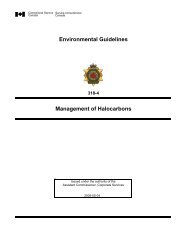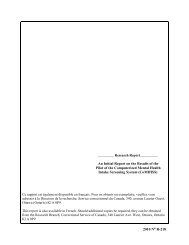Program and Service Needs of Federally Incarcerated Métis ...
Program and Service Needs of Federally Incarcerated Métis ...
Program and Service Needs of Federally Incarcerated Métis ...
You also want an ePaper? Increase the reach of your titles
YUMPU automatically turns print PDFs into web optimized ePapers that Google loves.
the family unit. However, little information is currently available on the needs <strong>of</strong> First<br />
Nations <strong>and</strong> non-Aboriginal families, making it difficult to draw comparisons.<br />
Nonetheless, it is imperative that correctional policies strongly consider the impact <strong>of</strong><br />
incarceration <strong>and</strong> subsequent release on the family unit. <strong>Service</strong>s may need to be<br />
enhanced to better address financial concerns. Furthermore, involving community<br />
members in the support <strong>of</strong> families may <strong>of</strong>fset some <strong>of</strong> the personal <strong>and</strong> social<br />
challenges they face.<br />
Staff Experience <strong>and</strong> Knowledge<br />
Correctional staff interviewed had extensive experience within federal corrections. Over<br />
two-thirds (69%) were employed in their current position for more than three years, <strong>and</strong><br />
85% were employed with the service for more than three years in total (including prior<br />
positions). A large proportion held other positions within CSC prior to their current<br />
position (92%). Of those who held a prior position, the majority was employed in<br />
correctional <strong>of</strong>ficer positions (92%).<br />
In addition to work with the general <strong>of</strong>fender population, institutional staff also appeared<br />
to have extensive experience with Aboriginal <strong>of</strong>fenders inside the institution (Table 14).<br />
All <strong>of</strong> the staff interviewed reported working with Aboriginal <strong>of</strong>fenders in general <strong>and</strong><br />
<strong>Métis</strong> <strong>of</strong>fenders specifically. Furthermore, fairly large proportions reported working with<br />
Aboriginal (69%) <strong>and</strong> <strong>Métis</strong> (31%) communities in some capacity. Similarly, all <strong>of</strong> those<br />
who held prior positions with CSC worked with Aboriginal <strong>of</strong>fenders in general <strong>and</strong> <strong>Métis</strong><br />
<strong>of</strong>fenders specifically. Furthermore, it appears that staff have received some instruction<br />
from CSC about Aboriginal issues. The majority (85%) <strong>of</strong> staff indicated that they<br />
received training pertaining to Aboriginal issues in the past. However, no staff had<br />
received training on <strong>Métis</strong> issues specifically. Results highlight the exposure<br />
institutional staff have had with the needs <strong>and</strong> issues <strong>of</strong> Aboriginal <strong>of</strong>fenders.<br />
28






